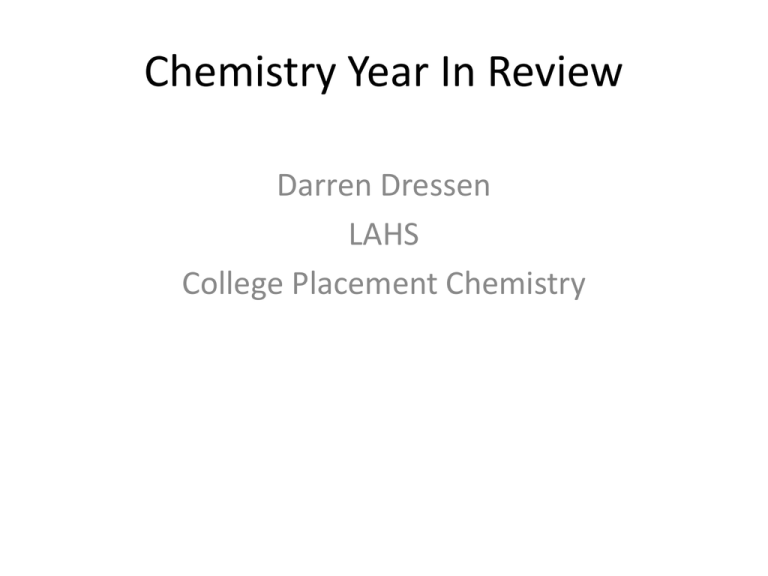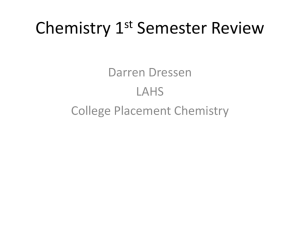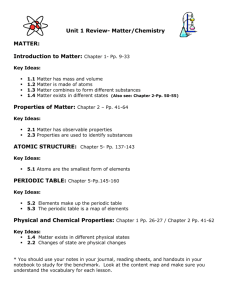Chemistry Year In Review
advertisement

Chemistry Year In Review Darren Dressen LAHS College Placement Chemistry Don’t Be This Cat! About one week ago I thought …… Rather Be This Kid! Take the alternate laboratory final exam Chapter 3 Scientific Measurement • Be able to convert back and forth between regular and scientific notation • Be able to convert back and forth between oC and Kelvin Chapter 4: Atomic Theory • Know the numbers of protons, electrons, and neutrons in a given atom • Understand the model of the atom in terms of its geography of particles and charge • Understand concept of atomic number • Know what an isotope is Chapter 25: Nuclear Chemistry • Explain the difference between fission and fusion • Be able to identify alpha, beta, or gamma particles • Be able to complete a nuclear reaction Chapter 25: Nuclear Chemistry • Explain the difference between fission and fusion • Be able to identify alpha, beta, or gamma particles • Be able to complete a nuclear reaction Chapter 5: Electrons in Atoms • Be able to determine number of valance electrons • Identify electron configurations of atoms • Know everything there is to know about electrons • Understand Einstein’s and Planck’s concept of quanta Cathode Ray Tube Chapter 6: Periodic Law • Understand properties of various families and groups from the periodic table • Be able to identify correct ions when looking at the periodic table • Know your periodic trends Chapter 7: Ionic Bonding • Be able to identify electron configurations of ions • Understand the concept of the ionic bond • Be able to identify atoms likely to form ionic bonds with each other Chapter 8: Covalent Bonding • Look at a chemical formula and be able to count the number of individual atoms • Identify lone pairs on Lewis structures • Be able to look at a molecular formula and determine its Lewis dot structure • Understand VSEPR theory Chapter 9: Nomenclature of Chemicals • When looking at a chemical formula, be able to determine charge on an individual atom • Be able to identify incorrect chemical formulas • Be able to match a written chemical name with a chemical formula Chapter 10: The Mole • Be able to convert back and forth between moles and number of atoms • Be able to calculate molar masses • Be able to identify standard pressure and temperature Chapter 11: Chemical Reactions • Know the different reaction types and be able to identify them • Be able to balance chemical equations Second Semester Material Chapter 12: Stoichiometry • Understand what the coefficients in front of chemicals in a reaction mean • What can I say … be able to use calculations to travel around mole city! For example, go from grams to liters, grams to molecules or vice versa. Chapter 13: States of Matter • Know the assumptions of kinetic molecular theory • Know physical property differences between ionic and molecular solids • Be able to identify various phase changes between states of matter Chapter 14: Behavior of Gases • Understand relationship between pressure, temperature, and volume in a closed system • Be able to use the gas laws in calculations • Understand the ideal gas law Chapter 15: Water and Aqueous Systems • Understand in detail the geometry and Lewis dot structure of water • Need I say … hydrogen bonding • Understand the different types of covalent bonds … (back to chapter 8) • Understand the concept of “like dissolves like” Chapter 16: Solutions • Colloids, suspensions, and solutions and the Tyndall effect • Be able to calculate molarity of solutions • Be able to do dilution calculations • Be able to identify colligative properties and understand how they operate Chapter 17: Thermochemistry • Understand and describe the movement of heat • Be able to do heat calculations • Understand calorimetry and how to use the concept in calculations • Understand what happens to temperature of a substance as it is heated up and goes through phase changes • Conceptually understand what specific heat is and how it varies in different substances Chapter 18: Kinetics and Equilibrium • Explain what activation energy is and how it is related to reactants and products • Understand how Le Chatelier’s Principle affects a reaction equilibrim. • Understand how a catalyst affects the progression of a reaction Chapter 19: Acids and Bases • Be able to identify properties of acids and bases • Calculate pH or pOH from concentration • Perform titration calculations • Make comparisons between strong and weak acids or bases Chapter 22: Hydrocarbons • Be able to associate the number of carbons with the name of a hydrocarbon • Know what the suffixes –ane, -ene, and –yne imply about a compound Esters rock dude!!! Don’t Be Unprofessional: Come Prepared • Bring several sharpened pencils and eraser • Don’t forget your notecard(s) • Bring your periodic table with reference sheet (ref. sheet on back) • Bring your own scientific calculator, you cant use your phone!!! • Arrive early






